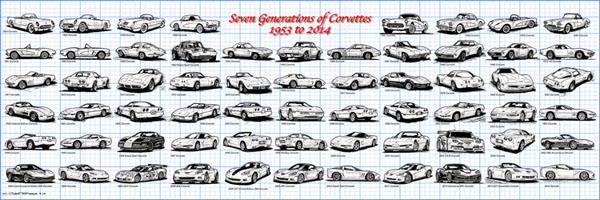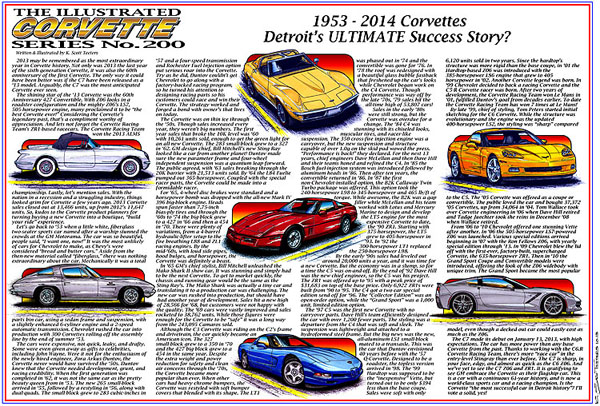Illustrated Corvette Series No. 200 1953 – 2014 Corvette
“DETROIT’S ULTIMATE SUCCESS STORY?” by K Scott Teeters as originally published in Vette magazine
In the February 2014 issue of VETTE Magazine, I celebrated my 200th installment of The Illustrated Corvette Series with a look back at the entire history of the Corvette. The title of the column is, “DETROIT’S ULTIMATE SUCCESS STORY?” The Corvette has come a very long way from being a car that many inside GM wanted to kill off to becoming General Motors’ flagship halo car.
While the article in VETTE only shows one Corvette from all seven generations of Corvettes, I wanted to do something extra special. So, I created the 1’ x 3’, “Seven Generations of Corvettes 1953-2014 Corvettes” art print, available through our Fine Art America store, HERE.
The print is available in a variety of sizes and can be custom framed right from the site.
Here is the story……..
2013 may be remembered as the most extraordinary year in Corvette history. Not only was 2013 the last year of the sixth generation Corvette, it was also the 60th anniversary of the first Corvette. The only way it could have been better was if the C7 have been released as a ‘13 model. Arguably, the C7 was the most anticipated Corvette ever seen.
The shining star of the ‘13 Corvette was the 60th Anniversary 427 Convertible. With Z06 looks in a roadster configuration and the mighty Z06’s LS7, 505-horsepower engine, many proclaimed it to be “the best Corvette ever!” Considering the Corvette’s legendary past, that’s a compliment worthy of appreciation. And lets not forget the Corvette Racing Team’s ZR1-based racecars. The Corvette Racing Team (as of this writing) is poised to win another championship. Lastly, let’s mention sales. With the nation in a recession and a struggling industry, things looked grim for Corvette a few years ago. 2013 Corvette sales closed out at 13,466 units, up from 2012’s 11,647 units. So, kudos to the Corvette product planners for turning buying a new Corvette into a boutique, “build your ride” experience.
Let’s go back to ‘53 when a little white, fiberglass two-seater sports car named after a warship stunned the crowds at the GM Motorama. The car was so beautiful, people said, “I want one, now!” It was the most unlikely of cars for Chevrolet to make, as Chevy’s were considered “bread and butter cars.” Aside from the then-new material called “fiberglass,” there was nothing extraordinary about the car. Mechanically it was a total parts bin car, using a sedan frame and suspension, with a slightly enhanced 6-cyliner engine and a 2-speed automatic transmission. Chevrolet rushed the car into production with 300 Corvettes rolling off the assembly line by the end of summer ‘53.
The cars were expensive, not quick, leaky, and drafty. Some were even given away as gifts to celebrities, including John Wayne. Were it not for the enthusiasm of the newly hired engineer, Zora Arkus-Duntov, the Corvette never would have survived the ‘50s. Duntov knew that the Corvette needed development, grunt, and racing credibility. When the first generation was completed in ‘62, it was not the same car as the pretty beauty queen from in ‘53. The new 265 small-block arrived in ‘55, followed by a restyling in ‘56, along with dual-quads. The small-block grew to 283 cubic-inches in ‘57 and a four-speed transmission and Rochester Fuel Injection option put serious roar into the Corvette. Try as he did, Duntov couldn’t get Chevrolet to go along with a factory-backed racing program, so he turned his attention to designing racing parts so his customers could race and win their Corvette. The strategy worked and forged a bond with owner’s that lives on today.
The Corvette was on thin ice through the ‘50s. Though sales increased every year, they weren’t big numbers. The first year sales that broke the 10K level was ‘60 with 10,261 units sold, enough to get the green light for an all-new Corvette. The 283 small-block grew to a 327 in ‘62. GM design chief, Bill Mitchell’s new Sting Ray looked like a car from another planet! Duntov made sure the new parameter frame and four-wheel independent suspension was a quantum leap forward. The public agreed, with ‘63 sales breaking through the 20K barrier with 21,513 units sold. By ‘64 the L84 Fuelie pumped out 365-horsepower. Coupled with the special racer parts, the Corvette could be made into a formidable racer.
For ‘65, 4-wheel disc brakes were standard and a horsepower bomb was dropped with the all-new Mark IV 396 big-block engine. Heads spun faster than 7.75-inch bias-ply tires and through the ‘60s to ‘74 the big-block grew to a 427 in ‘66 and then a 454 in ‘70. There were plenty of variations, from a 4-barrel hydraulic-lifter setup to the fire breathing L88 and ZL1 racing engines. By the mid-‘60s, with loud side pipes, hood bulges, and horsepower, the Corvette was definitely a beast.
In ‘65 GM’s chief stylist, Bill Mitchell unleashed the Mako Shark II show car. It was stunning and simply had to be the next Corvette. To get to market quickly, the chassis and running gear would be the same as the Sting Ray’s. The Mako Shark was actually a tiny car and translating it to a production car was challenging. The new car was rushed into production, but should have had another year of development. Sales hit a new high of 28,566 for ‘68, but customers were not happy with the quality. The ‘69 cars were vastly improved and sales rocketed to 38,762 units. While those figures were enough for the Corvette to be “safe” it was a long way from the 243,095 Camaros sold.
Although the C3 Corvette was riding on the C2’s frame and drivetrain, the car quickly became an American icon. The 327 small-block grew to a 350 in ‘70 and the 427 big-block grew to a 454 in the same year. Despite the extra weight and power reduction for safety and clean air concerns through the ‘70s, the Corvette became more popular than ever. When other cars had heavy chrome bumpers, the Corvette was restyled with soft bumper covers that blended with its shape. The LT1 was phased out in ‘74 and the convertible was gone for ‘76. In ‘78 the roof was redesigned with a beautiful glass bubble fastback that freshened up the car’s looks while Chevrolet began work on the C4 Corvette. Though performance was way off by the late ‘70s, ‘79 sales hit the all-time high of 53,807 cars!
Sales in the early ‘80s were still strong, but the Corvette was overdue for a change. The ‘84 C4 was stunning with its chiseled looks, muscular tires, and racer-like suspension. The 350 cross-fire injection engine was a carryover, but the new suspension and structure capable of over 1.0g on the skid pad wowed the press. “Performance is back!” they declared. For the next 13 years, chief engineers Dave McLellan and then Dave Hill and their teams honed and refined the C4. In ‘85 the Bosch fuel-injection system was introduced followed by aluminum heads in ‘86. Then after ten years, the convertible returned in ‘86. In ‘87 the first non-Chevrolet-installed option, the B2K Callaway Twin Turbo package was offered. This option took the 240-horsepower L98 to 345-horsepower and 465 lb/ft of torque. While awesome, the B2K was a gap filler while McLellan and his team worked with Lotus and Mercury Marine to design and develop the LT5 engine for the most expensive Corvette to date, the ‘90 ZR1. Starting with 375-horsepower, the LT5 grew to 405-horsepower in ‘93. In ‘92 the 300-horsepower LT1 replaced the 250-horsepower L98.
By the early ‘90s sales had leveled out around 20,000 units a year, and it was time for a new Corvette. But the economy was in a slump, so for a time the C5 was on-and-off. By the end of ‘92 Dave Hill was the new chief engineer, so the C5 was his project. The ZR1 was offered up to ‘95 with a peak price of $31,683 on top of the base price. Only 6,922 ZR1s were built from ‘90 to ‘95. The C4 got a two car special edition send off for ‘96. The “Collector Edition” was an open-order option, while the “Grand Sport” was a 1,000 unit, limited edition option.
The ‘97 C5 was the first new Corvette with no carryover parts. Dave Hill’s team efficiently designed the car with over 1,200 fewer parts. The styling was a departure from the C4 that was soft and sleek. The suspension was lightweight and attached to a hydroformed steel frame. But the big news was the new, all-aluminum LS1 small-block mated to a transaxle. This was the car that Duntov envisioned 40 years before with the ‘57 Q-Corvette. Designed to be a roadster, the topless version arrived in ‘98. The ‘99 Hardtop was supposed to be the “inexpensive” Vette, but turned out to be only $394 less than the base coupe. Sales were soft with only 6,120 units sold in two years. Since the hardtop’s structure was more rigid than the base coupe, in ‘01 the Hardtop-based Z06 was introduced with the 385-horsepower LS6 engine that grew to 405 horsepower in ‘02. Another Corvette legend was born. In ‘99 Chevrolet decided to back a racing Corvette and the C5-R Corvette racer was born. After two years of development, the Corvette Racing Team won Le Mans in ‘01, fulfilled Duntov’s goal from decades earlier. To date the Corvette Racing Team has won 7 times at Le Mans!
By late ‘99, chief of styling, Tom Peters started initial sketching for the C6 Corvette. While the structure was evolutionary and the engine was the updated 400-horsepower LS2, the styling was “sharp” compared to the C5. The ‘05 Corvette was offered as a coupe or convertible. The public loved the car and bought 37,372 ‘05 Corvettes, up from 34,064 in ‘04. Tom Wallace took over Corvette engineering in ‘06 when Dave Hill retired and Tadge Juechter took the reins in December ‘08 when Wallace retired.
From ‘06 to ‘10 Chevrolet offered one stunning Vette after another. In ‘06 the 505-horsepower LS7-powered Z06 was launched. Various special editions arrived beginning in ‘07 with the Ron Fellows Z06, with yearly special edition through ’13. In ‘09 Chevrolet blew the lid off with the first-ever, factory-built, supercharged Corvette, the 635-horsepower ZR1. Then in ‘10 the Grand Sport Coupe and Convertible models were introduced, offering the look of the Z06 widebody with unique trim. The Grand Sport became the most popular model, even though a decked out car could easily cost as much as the Z06.
The C7 made its debut on January 13, 2013, with high expectations. The car has more power than any base Corvette from the past. Thanks to working with the C6.R Corvette Racing Team, there’s more “race car” in the entry-level Stingray than ever before. The C7 is sharp, in your face, edgy, and almost as quick as the C6 Z06. And we’ve yet to see the C7 Z06 and ZR1. It is gratifying to see GM embrace the Corvette as their flagship car. This is a car with a continuous 61-year history, and is now a world-class sports car and a racing champion. Is the Corvette “the most successful car in Detroit history”? I’ll vote a solid, yes!
You may purchase the print below on Amazon, HERE.
-Save the Wave, Scott


